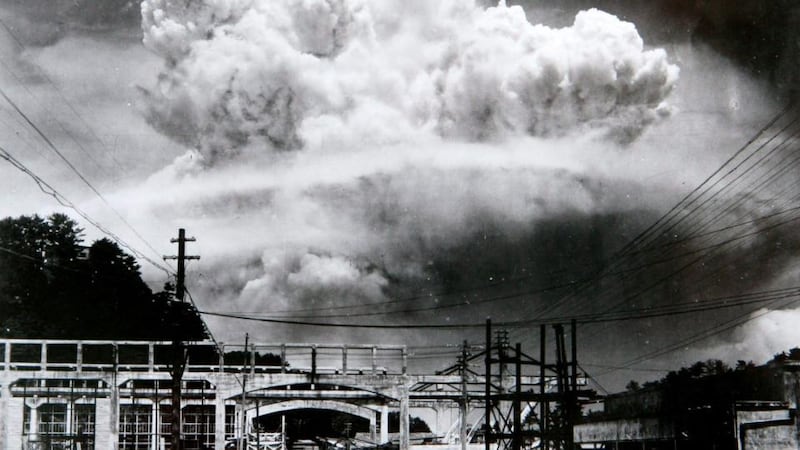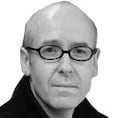Luck and geography decided life or death in Nagasaki. Hirotami Yamada survived because he was at school, more than 3km from the hypocentre of the plutonium bomb dropped over the city on August 9th, 1945. The flash and heat from the detonation felt like the sun had fallen from the sky; then everything went dark, he says. When the light returned, much of Nagasaki was vaporised in a cloud of smoke and dust that barrelled a mile up into the clouds.
Yamada, then 14, recalls afterwards walking through the seared, flattened landscape to find his family, 900m from where the bomb exploded. Charred, blind survivors begged the able-bodied for water. “I saw people so injured along the way that you couldn’t tell if they were alive or dead,” he says. “But my family looked unhurt, just scratches. We were so relieved.”
By the end of the summer, they would nearly all be dead.

First to go was his nine-month-old brother, Takashi, who cried incessantly before finally falling quiet. His mother shook him then fell asleep holding the dead baby in her arms, asking, “Why did he die?”
When morning came, his 16-year-old sister, Misao, had stopped breathing too, he says. Before the bodies could rot in the baking heat, Yamada scoured the neighbourhood for wood and built a makeshift pyre.
As the corpses burned, his mother was silent, staring at the ground. Now 84, Yamada still regrets not protecting her from the sight. “I didn’t know, as a child, how she must have felt.”
He packed the ashes and bones into an empty can of baby-milk powder. Takashi’s remains fit easily, he says, but the bones of his sister were too big. He wrapped the makeshift urn in a piece of cloth, and buried it in a patch of scorched ground.
Obscured
Nagasaki was a victim of bad weather, and fate. The initial target, the city of
Kokura
, was obscured by cloud and haze. US president
Harry Truman
had called the destruction of
Hiroshima
three days earlier, along with about 140,000 human beings, “the greatest thing in history” and predicted it would end the second World War. When
Japan
showed no sign of surrender, pilot
Charles Sweeney
was sent back with a second bomb.
The bomb, codenamed "Fat Man" and dropped from the Bockscar B-29 bomber, took 70,000 lives and destroyed Urakami church, Asia's largest Catholic cathedral, the heart of Japan's oldest Christian community. Sweeney, an Irish-American Catholic who had also flown in the Enola Gay, which bombed Hiroshima, never publicly expressed regret. "There's no question in my mind that President Truman made the right decision," he later said.
Japan's military campaign in Asia, studded with atrocities that included the bombing and mass murder of civilian populations in China, helped fuel America's entry into the war in 1941. Truman's predecessor, Franklin D Roosevelt, had said the "inhuman barbarism" of indiscriminate bombing had "sickened the hearts of every civilised man and woman" and "profoundly shocked the conscience of humanity".
Yet, a few years later the situation had been almost completely reversed, noted historian John Dower. The US and British air forces became the "apostles of strategic bombing" and perfected the techniques of urban destruction, fuelled by an annihilationist policy against Japan that culminated in the incineration of most its cities and the death of more than 400,000 civilians. A poll in late 1945 found more than 22 per cent of Americans wished more atomic bombs had been dropped on Japan.
But what was left to destroy? Yoshitoshi Fukahori, who was 16 when Nagasaki was bombed, remembers so little was left standing, he had to use the ruins of Urakami church to navigate. He also recalls his terror as victims emerged from the ruined city, begging for water.
“They were clinging to my legs,” he says. “I filled an old cider bottle with water and gave each one a sip, but it was a mistake. More came, their mouths open, and I grew afraid. So I ran away.”
Today, Fukahori is one of 200,000 elderly survivors from both A-bombings recognised by Japan's government. They are monitored and carry a card that gives them lifelong health benefits. The hibakusha, as they are known, are a political lobby, lending the moral weight of their suffering to the global antinuclear cause. But they are often reluctant campaigners.
“Most of us don’t want to talk about what happened,” says Yamada.
Many are angry with the government of prime minister Shinzo Abe, who wants Japan to become a more active military partner with the US, its old enemy. Abe's "proactive pacifism" will make Japan the proxy army of the US, say the hibakusha, pulling the nation away from the antiwar ideals survivors of Hiroshima and Nagasaki have symbolised since 1945.
Tomihisa Taue, Nagasaki’s mayor, says he understands these concerns but is reluctant to be drawn into criticism of the central government.
“I think Mr Abe needs to explain carefully why these changes are needed,” he says. Whatever happens, his city must keep explaining the inhumanity of nuclear weapons. “We have a mission to communicate that to the world.”
The legacy of Nagasaki is still fought over. The US government plans to turn the New Mexico sites used to develop and test the first A-bomb into a national historical park. Taue says the park must record the suffering caused by nuclear weapons and not simply celebrate their creation.
“We are concerned that America should record what happened below the mushroom cloud, and not just above it.”
Radiation
Yamada is recovering from lung cancer, the same disease that killed his father in 1961. Nobody can prove the cancer came from the bomb, he says; his father was a heavy smoker. But he has lost many friends to the disease. At first they thought the Americans had dropped poison gas before learning about radiation, the deadly toxin left behind by the “Fat Man”.
“Nobody told us anything,” he says.
His mother died in hospital towards the end of that summer of 1945, listless and exhausted, unable to say goodbye. A few days later, his brother Akira, who was 12, also died, his body weakened by vomiting and bloody diarrhoea. His father was badly ill but recovered as the scorching summer waned. The two surviving members of the family never talked about what happened, he says. They just got on with life.
As we walk around the city’s Peace Memorial Park, looking for a place to shoot photographs, we briefly stop below a statue at the entrance: a mother holding a dead baby with a plaque beneath showing the date and time of the bombing. Yamada grimaces. “I hate this statue,” he says. “It’s too pretty. The reality was much uglier, too ugly to describe.”








